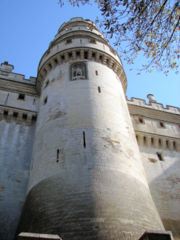
Machicolation
Encyclopedia

Corbel
In architecture a corbel is a piece of stone jutting out of a wall to carry any superincumbent weight. A piece of timber projecting in the same way was called a "tassel" or a "bragger". The technique of corbelling, where rows of corbels deeply keyed inside a wall support a projecting wall or...
s of a battlement
Battlement
A battlement in defensive architecture, such as that of city walls or castles, comprises a parapet , in which portions have been cut out at intervals to allow the discharge of arrows or other missiles. These cut-out portions form crenels...
, through which stones, or other objects, could be dropped on attackers at the base of a defensive wall
Defensive wall
A defensive wall is a fortification used to protect a city or settlement from potential aggressors. In ancient to modern times, they were used to enclose settlements...
. The design was developed in the Middle Ages
Middle Ages
The Middle Ages is a periodization of European history from the 5th century to the 15th century. The Middle Ages follows the fall of the Western Roman Empire in 476 and precedes the Early Modern Era. It is the middle period of a three-period division of Western history: Classic, Medieval and Modern...
when the Norman
Normans
The Normans were the people who gave their name to Normandy, a region in northern France. They were descended from Norse Viking conquerors of the territory and the native population of Frankish and Gallo-Roman stock...
crusaders
Crusades
The Crusades were a series of religious wars, blessed by the Pope and the Catholic Church with the main goal of restoring Christian access to the holy places in and near Jerusalem...
returned. A machicolated battlement projects outwards from the supporting wall in order to facilitate this. A hoarding
Hoarding (castles)
A hoarding was a temporary wooden construction that was placed on the exterior of the ramparts of a castle during a siege.The purpose of a hoarding was to allow the defenders to improve their field of fire along the length of a wall and, most particularly, directly downwards to the wall base.The...
is a similar structure made of wood, usually temporarily constructed in the event of a siege. Advantages of machicolations over wooden hoardings include the greater strength of stone battlements, as well as the fireproof properties.
The word derives from the Old French
Old French
Old French was the Romance dialect continuum spoken in territories that span roughly the northern half of modern France and parts of modern Belgium and Switzerland from the 9th century to the 14th century...
word *machecol, mentioned in Medieval Latin as machecollum and ultimately from Old French macher 'crush', 'wound' and col 'neck'. Machicolate is only recorded in the 18th c. in English, but a verb machicollāre is attested in Anglo-Latin. The Spanish word denoting this structure, matacán, is similarly composed from "matar canes" meaning roughly "killing dogs", the latter being a reference to infidel
Infidel
An infidel is one who has no religious beliefs, or who doubts or rejects the central tenets of a particular religion – especially in reference to Christianity or Islam....
s. A variant of a machicolation, set in the ceiling
Ceiling
A ceiling is an overhead interior surface that covers the upper limit of a room. It is generally not a structural element, but a finished surface concealing the underside of the floor or roof structure above....
of a passage, was colloquially known as a murder-hole
Murder-hole
A murder hole or meurtrière is a hole in the ceiling of a gateway or passageway in a fortification through which the defenders could fire, throw or pour harmful substances, such as rocks, arrows, scalding water, hot sand, quicklime, tar, or boiling oil, down on attackers. They also allowed water to...
.
Machicolations were more common in French castles than their English contemporaries, and when used in English castles they were usually restricted to the gateway, as in the 13th-century Conwy Castle
Conwy Castle
Conwy Castle is a castle in Conwy, on the north coast of Wales.It was built between 1283 and 1289 during King Edward I's second campaign in North Wales....
.
Post-medieval use
Machicolation was later used for decorative effect with spaces between the corbels but without the openings, and subsequently became a characteristic of the many non-military buildings (for example, some Scottish and Gothic buildings) of the 19th and 20th centuries. One of the first examples of machicolation that still exists in France is Chateau de FarchevilleChâteau de Farcheville
The Château de Farcheville is a 14th century castle in Bouville near Paris in the department of Essonne.The castle was built by the Hugues II and Hugues III, Lords of Farcheville and Bouville. The great hall was built in 1291 and the castle chapel was consacrated in 1304. Both father and son were...
built in 1291 outside of Paris.

